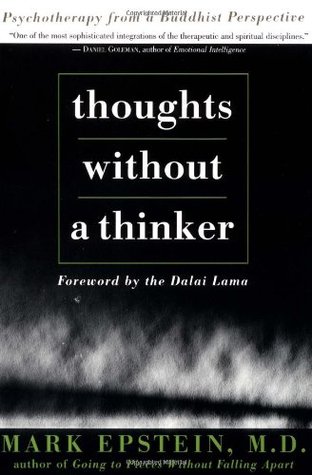Thoughts Without a Thinker Summary
6 min read ⌚

Psychotherapy from a Buddhist Perspective
The Ancient Greeks had a saying: “wisdom arises from suffering.” Unlike them who debated its veracity, about the same time far on the East, Gautama Buddha was convinced that, behind it, a great truth about man’s existence lies hidden.
So, he made this saying the key tenant of his personal philosophy.
Two and half millennia later, his followers, modern Zen Buddhist experts, and prominent neuroscientists say that he was onto something.
In “Thoughts Without a Thinker,” Mark Epstein, a renowned psychotherapist, has his say on the subject.
And, once again, we’ve prepared a neat summary for you.
Who Should Read “Thoughts Without a Thinker”? And Why?
“Thoughts Without a Thinker” is a psychoanalytical book about pain and suffering, so people suffering from anxiety and depression may find reading it a soothing and enlightening experience. In fact, since our world is a world of unhappiness, even those who are merely sad may find more than one reason to enjoy this book.
In addition, people interested in Buddhism will certainly like to find out how a modern psychoanalyst of prominence reads Buddha’s messages thousands of years after they were uttered.
About Mark Epstein
 Mark Epstein is an American psychoanalyst whose two main focuses of attention are trauma and Buddhism. Consequently, most of his books concentrate on combining the worldviews of Buddha and Sigmund Freud, resulting in a series of books popular both in the religious and the popular science community.
Mark Epstein is an American psychoanalyst whose two main focuses of attention are trauma and Buddhism. Consequently, most of his books concentrate on combining the worldviews of Buddha and Sigmund Freud, resulting in a series of books popular both in the religious and the popular science community.
In addition to “Thoughts Without a Thinker,” he is most famous for “The Trauma of Everyday Life,” and “Going to Pieces without Falling Apart: A Buddhist Perspective on Wholeness.” His most recent book is “Advice Not Given.” You can reach him at his website: http://markepsteinmd.com/.
Thoughts Without a Thinker Summary
Sigmund Freud was interested in many things. He wasn’t, however, interested in Buddhism!
Yet, as Mark Epstein shows, when it comes to Truth, the paths may be many, but the truth will always be the same. In other words, even though Freud knew nothing of Buddha, he discovered some things eerily similar to the ones the Indian prophesied.
For example, Buddha believed that we can’t understand ourselves because of three things: desire, anger, and delusion. Represented by a snake, a rooster, and a black hog biting each other’s tales in Buddhism’s “Wheel of Life,” these three feelings are problematic for Freud as well.
He just named them differently.
For example, in Freud, the snake of desire is called Eros, or the “life drive.” It’s what makes us strive for pleasant experiences and reject pain. It’s also what stops us from seeing our true selves.
The rooster of anger is Thanatos for Freud or the “death drive.” It’s the instinct which makes people do crazy things such as bungee jumping and boxing. Think of a situation when someone yelled at you! What you repressed at the moment is “the death drive.”
Finally, the black hog of delusion! It’s central to both Freudism and Buddhism.
It refers to the idea we have of ourselves – and which is, more than certainly, a wrong idea. We don’t really know ourselves because we are deliberately trying to create a different self every time an unpleasant situation arises.
And this goes way back!
You left your Garden of Eden the moment your mother stopped breastfeeding you! Everything which happened afterward – sorry to break this to you! – is a lie.
And that’s how psychological disorders came to be!
Disorders are nothing more but a friction between your actual self and the self you created. Your true nature wants to scream and run around naked; your social self-obliges you to wear a suit and whisper. In time, the tension may become overbearing.
And there’s no way out!
Even at the moment, you’re reading this, your self is not aligned with who you really are. It’s either inflated or deflated. In the first case, you suffer from narcissism, while in the second – from depression. In the first case, you believe that you’re the center of the world, while in the second – that you don’t matter.
Needless to say – neither is true.
All Buddhism ever speaks about is how you can free yourself from your self.
Buddha remained silent when a student asked him if his self-existed. That was his way of claiming that whatever he says, would be a reinforcement of the self. Staying silent allowed him to be above the situation.
And you can do this too!
You already know the equation: meditation + compassion. Mediation can help you negate your self by quieting your mind; compassion by sacrificing it for others.
It is exactly through these kinds of techniques that Easterners have achieved mindfulness and humility. Westerners still struggle with desire, loneliness, and delusion. Buddhists have a phrase for it: “hungry ghosts.”
Does it sound eerie enough?
Unfortunately, it’s grounded in reality. In fact, this is not only where Westerners and Easterners differ, but it’s also where psychoanalysis and Buddhism take separate paths.
Unlike Buddhism, psychoanalysis doesn’t try to cancel out the self; it tries to uncover it. According to Epstein – that’s the selfish way of science. Overanalyzing things to find an impractical answer.
Even though at first sight much more idealistic, Buddhism is the more pragmatic philosophy in this case.
Because it isn’t afraid to tackle the problem.
Because, ultimately, it finds the solution.
Key Lessons from “Thoughts Without a Thinker”
1. Buddha and Freud Have Few Things in Common
2. You May Know Yourself – But You Don’t Know Your Self
3. Be a Buddhist: You’ll Be Happier
Buddha and Freud Have Few Things in Common
Freud didn’t care for Buddha, but his idea of the undetermined self as the central problem of human’s happiness is a thing he shares with the Indian religious thinker. In fact, both Freud and Buddha believe that our self is shielded from us because of desire, anger, and delusion.
They just name the feelings differently. But, the essence stays the same.
You May Know Yourself – But You Don’t Know Your Self
Even though you may be able to answer the question “Who you are?” the answer you’re giving yourself is certainly not the right one. Because to shield yourself from further pain, you’ve either inflated or deflated your self.
In the first case, you’re a narcissist; in the second, you suffer from depression. Neither will help you reach happiness.
Be a Buddhist: You’ll Be Happier
But, probably finding your true self will yield no results either. Because, it’s not about discovering it – it’s about eliminating it. Meditation and compassion are two safe paths towards this. The first helps you to quiet your desires and anger, and the second to sacrifice your self for the other.
Both lead to mindfulness which is the ultimate goal of Buddhism.
And which should be your ultimate goal as well.
Like this summary? We’d Like to invite you to download our free 12 min app, for more amazing summaries and audiobooks.
“Thoughts Without a Thinker” Quotes
The Buddhist picture of the Wheel of Life… has always seemed a particularly useful starting place in comparing Buddhist and Western notions of suffering and psychological health. Share on X Freud traced the universality of human suffering to the coexistence of two irrefutable facts: first, the young child’s helplessness and dependence; second, the same child’s psychosexual prematurity. Share on X The First Noble Truth of the Buddha asks us, above all, to accept the uncertainties that we otherwise try to ignore. In so doing, we can then appreciate the rest of the Buddha’s psychology. Share on X The self, according to the Buddha’s language of the ancient Sutras, is a fiction—a mirage, a shadow, or a dream. In today’s psychodynamic language, we would call it a fantasy, a pretense, or a wish. Share on X States of well–being are inherently unstable; they may temporarily counter the symptoms of alienation, but they are not a cure. Share on XOur Critical Review
“Thoughts Without a Thinker” is a book which tries to combine two seemingly disparate worlds: Western psychoanalysis and Buddhism. And it does quite a good job!
The book is thought-provoking, but, unfortunately, it is written in much more technical and much less reader-friendly style when compared to other books by Epstein. As a result, we guess that the book will be much more interesting to learned psychoanalysts than to the general public.
But, don’t take our word for it and try it! In fact, many people say that the lessons in this book genuinely helped them. And, let’s face it, the book is recommended by someone much more autorotative than us on all matters Buddhism.
After all, how many authors can say that their book has a foreword written by the Dalai Lama himself?
Emir is the Head of Marketing at 12min. In his spare time, he loves to meditate and play soccer.







